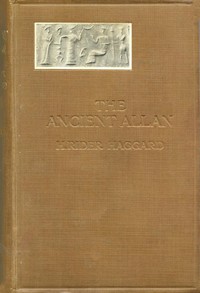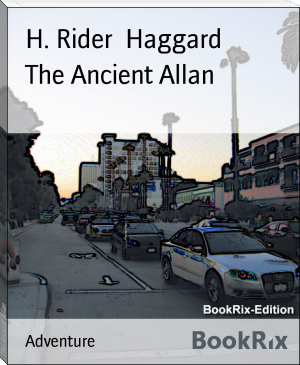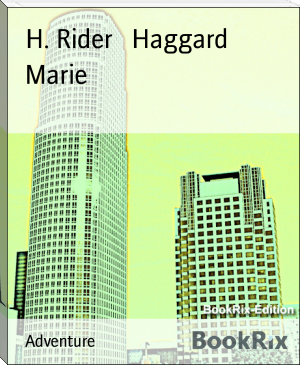The Ancient Allan, H. Rider Haggard [interesting novels in english .TXT] 📗

- Author: H. Rider Haggard
Book online «The Ancient Allan, H. Rider Haggard [interesting novels in english .TXT] 📗». Author H. Rider Haggard
I was working myself up to write to her when one morning the postman brought me here at the Grange a letter which had “Ragnall Castle” printed on the flap of the envelope. I did not know the writing which was very clear and firm, for as it chanced, to the best of my recollection, I had never seen that of Lady Ragnall. Here is a copy of the letter it contained:
“MY DEAR MR. QUATERMAIN,—Very strangely I have just seen at a meeting of the Horticultural Society, a gentleman who declares that a few days ago he sat next to you at some public dinner. Indeed I do not think there can be any doubt for he showed me your card which he had in his purse with a Yorkshire address upon it.
“A dispute had arisen as to whether a certain variety of Crinum lily was first found in Africa, or Southern America. This gentleman, an authority upon South American flora, made a speech saying that he had never met with it there, but that an acquaintance of his, Mr. Quatermain, to whom he had spoken on the subject, said that he had seen something of the sort in the interior of Africa.” (This was quite true for I remembered the incident.) “At the tea which followed the meeting I spoke to this gentleman whose name I never caught, and to my astonishment learnt that he must have been referring to you whom I believed to be dead, for so we were told a long time ago. This seemed certain, for in addition to the evidence of the name, he described your personal appearance and told me that you had come to live in England.
“My dear friend, I can assure you it is long since I heard anything which rejoiced me so much. Oh! as I write all the past comes back, flowing in upon me like a pent-up flood of water, but I trust that of this I shall soon have an opportunity of talking to you. So let it be for a while.
“Alas! my friend, since we parted on the shores of the Red Sea, tragedy has pursued me. As you will know, for both my husband and I wrote to you, although you did not answer the letters” (I never received them), “we reached England safely and took up our old life again, though to tell you the truth, after my African experiences things could never be quite the same to me, or for the matter of that to George either. To a great extent he changed his pursuits and certain political ambitions which he once cherished, seemed no longer to appeal to him. He became a student of past history and especially of Egyptology, which under all the circumstances you may think strange, as I did. However it suited me well enough, since I also have tastes that way. So we worked together and I can now read hieroglyphics as well as most people. One year he said that he would like to go to Egypt again, if I were not afraid. I answered that it had not been a very lucky place for us, but that personally I was not in the least afraid and longed to return there. For as you know, I have, or think I have, ties with Egypt and indeed with all Africa. Well, we went and had a very happy time, although I was always expecting to see old Harût come round the corner.
“After this it became a custom with us who, since George practically gave up shooting and attending the House of Lords, had nothing to keep us in England, to winter in Egypt. We did this for five years in succession, living in a bungalow which we built at a place in the desert, not far from the banks of the Nile, about half way between Luxor which was the ancient Thebes, and Assouan. George took a great fancy to this spot when first he saw it, and so in truth did I, for, like Memphis, it attracted me so much that I used to laugh and say I believed that once I had something to do with it.
“Now near to our villa that we called ‘Ragnall’ after this house, are the remains of a temple which were almost buried in the sand. This temple George obtained permission to excavate. It proved to be a long and costly business, but as he did not mind spending the money, that was no obstacle. For four winters we worked at it, employing several hundred men. As we went on we discovered that although not one of the largest, the temple, owing to its having been buried by the sand during, or shortly after the Roman epoch, remained much more perfect than we had expected, because the early Christians had never got at it with their chisels and hammers. Before long I hope to show you pictures and photographs of the various courts, etc., so I will not attempt to describe them now.
“It is a temple to Isis—built, or rather rebuilt over the remains of an older temple on a site that seems to have been called Amada, at any rate in the later days, and so named after a city in Nubia, apparently by one of the Amen-hetep Pharaohs who had conquered it. Its style is beautiful, being of the best period of the Egyptian Renaissance under the last native dynasties.
“At the beginning of the fifth winter, at length we approached the sanctuary, a difficult business because of the retaining walls that had to be built to keep the sand from flowing down as fast as it was removed, and the great quantities of stuff that must be carried off by the tramway. In so doing we came upon a shallow grave which appeared to have been hastily filled in and roughly covered over with paving stones like the rest of the court, as though to conceal its existence. In this grave lay the skeleton of a large man, together with the rusted blade of an iron sword and some fragments of armour. Evidently he had never been mummified, for there were no wrappings, canopic jars, ushapti figures or funeral offerings. The state of the bones showed us why, for the right forearm was cut through and the skull smashed in; also an iron arrow-head lay among the ribs. The man had been buried hurriedly after a battle in which he had met his death. Searching in the dust beneath the bones we found a gold ring still on one of the fingers. On its bezel was engraved the cartouche of ‘Peroa, beloved of Ra.’ Now Peroa probably means Pharaoh and perhaps he was Khabasha who revolted against the Persians and ruled for a year or two, after which he is supposed to have been defeated and killed, though of his end and place of burial there is no record. Whether these were the remnants of Khabasha himself, or of one of his high ministers or generals who wore the King’s cartouche upon his ring in token of his office, of course I cannot say.
“When George had read the cartouche he handed me the ring which I slipped upon the first finger of my left hand, where I still wear it. Then leaving the grave open for further examination, we went on with the work, for we were greatly excited. At length, this was towards evening, we had cleared enough of the sanctuary, which was small, to uncover the shrine that, if not a monolith, was made of four pieces of granite so wonderfully put together that one could not see the joints. On the curved architrave as I think it is called, was carved the symbol of a winged disc, and beneath in hieroglyphics as fresh as though they had only been cut yesterday, an inscription to the effect that Peroa, Royal Son of the Sun, gave this shrine as an ‘excellent eternal work,’ together with the statues of the Holy Mother and the Holy Child to the ‘emanations of the great Goddess Isis and the god Horus,’ Amada, Royal Lady, being votaress or high-priestess.
“We only read the hieroglyphics very hurriedly, being anxious to see what was within the shrine that, the cedar door having rotted away, was filled with fine, drifted sand. Basketful by basketful we got it out and then, my friend, there appeared the most beautiful life-sized statue of Isis carved in alabaster that ever I have seen. She was seated on a throne-like chair and wore the vulture cap on which traces of colour remained. Her arms were held forward as though to support a child, which perhaps she was suckling as one of the breasts was bare. But if so, the child had gone. The execution of the statue was exquisite and its tender and mystic face extraordinarily beautiful, so life-like also that I think it must have been copied from a living model. Oh! my friend, when I looked upon it, which we did by the light of the candles, for the sun was sinking and shadows gathered in that excavated hole, I felt—never mind what I felt—perhaps you can guess who know my history.
“While we stared and stared, I longing to go upon my knees, I knew not why, suddenly I felt a faint trembling of the ground. At the same moment, the head overseer of the works, a man called Achmet, rushed up to us, shouting out—‘Back! Back! The wall has burst. The sand runs!’
“He seized me by the arm and dragged me away beside of and behind the grave, George turning to follow. Next instant I saw a kind of wave of sand, on the crest of which appeared the stones of the wall, curl over and break. It struck the shrine, overturned and shattered it, which makes me think it was made of four pieces, and shattered also the alabaster statue within, for I saw its head strike George upon the back and throw him forward. He reeled and fell into the open grave which in another moment was filled and covered with the débris that seemed to grip me to my middle in its flow. After this I remembered nothing more until hours later I found myself lying in our house.
“Achmet and his Egyptians had done nothing; indeed none of them could be persuaded to approach the place till the sun rose because, as they said, the old gods of the land whom they looked upon as devils, were angry at being disturbed and would kill them as they had killed the Bey, meaning George. Then, distracted as I was, I went myself for there was no other European there, to find that the whole site of the sanctuary was buried beneath hundreds of tons of sand, that, beginning at the gap in the broken wall, had flowed from every side. Indeed it would have taken weeks to dig it out, since to sink a shaft was impracticable and so dangerous that the local officials refused to allow it to be attempted. The end of it was that an English bishop came up from Cairo and consecrated the ground by special arrangement with the Government, which of course makes it impossible that this part of the temple should be further disturbed. After this he read the Burial Service over my dear husband.
“So there is the end of a very terrible story which I have written down because I do not wish to have to talk about it more than is necessary when we meet. For, dear Mr. Quatermain, we shall meet, as I always knew that we should—yes, even after I heard that you were dead. You will remember that I told you so years ago in Kendah Land and that it would happen after a great change in my life, though what that change might be I could not say....”
This is the end of the letter except for certain suggested dates for the visit which she took for granted I should make to Ragnall.
RAGNALL CASTLE
When I had finished reading this amazing document I lit my pipe and set to work to think it over. The hypothetical inquirer might ask why I thought it amazing. There was nothing odd in a dilettante Englishman of highly cultivated mind taking to Egyptology and, being, as it chanced, one of the richest men in the kingdom, spending





Comments (0)